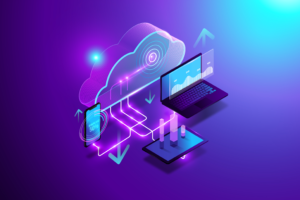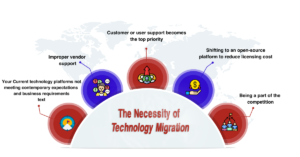The evolution of new technology every day and the old becoming obsolete demands frequent changes in the technological platform a business depends on. An updated technical platform is a must for companies that provides various services and platforms to their users without changing the current User Experience so that your employees continue to work.

Hence, the migration of an entire technological platform comes into the picture. A business can always migrate to a new and adequate platform. Technology migration provides a better and more evolved technical platform to access a better working environment and ease of business.
Types of Technology Migration
Security concerns may also usher to migration at times. There are many types of migration; however, it is a complex process. It takes a lot of planning and thought to make the correct decision and maintain operations as it happens.
A company can perform the following technological migration to update its business platform.
- Back-end migration
- Front-end migration
- Migration of CMS-built website
- Database migration
- Hosting server and domain migration, etc
As we can see, migration is an intricate process that takes lots of planning. You need to set some purposes and rules to carry out the migration process smoothly, pivoting on the project’s needs.
Is there a need for Technology Migration?
The first thing we need to detect is to check the dire necessity of migrating from the current technology platform to a new and more advanced one. Here is a list of need that makes technology migration quite crucial.

Easy Planning of Technology Migration
Now that we have understood the necessity of technology migration let us check the steps to comprehensively migrate to a better platform.
- Properly analyze the current technological platform for contemporary applications and projects demanding migration.
- Roadmap Preparation for calculating the risks and their possible solutions during the migration journey.
- Proper technology selection that supports your profound need and requirements for the projects.
- An appropriate plan for the execution of the process migration.
- Analyze new and advanced applications regarding functioning and compatibility and make mandatory changes if required.
According to these steps, set a budget matching the timeline of the migration process. It is not a fixed and estimated job. There will be changes in the plan, which need more focus and coordination with the service provider.
Scope Creep: A Crucial Point to Consider
The development team hired for the technology migration will face difficult situations based on the timeline and budget of the process. The changes to be made for technical requirements will extend the new platform’s commencement date and might increase the migration budget. This situation is called scope creep.
Let us find out about such scope creep.
- Improper analysis of the project requirements
Misunderstanding what is ideal for the project may result in blunders and a massive delay in the development process. It will also increase the budget by causing trouble in the later phases.
- Pitfalls that repeat
Seeking feedback from the clients will reveal the pitfalls of the outcome of a technology migration project resulting in quick mitigation. Considering all feedback points can be a drawback too.
- Uncontrollable external factors
Not preparing for the factors you cannot control can lead to improper results. Such external factors are abrupt market changes, economic changes, technological changes, trends, personal emergencies, etc.
Technology Stack Selection
Choosing a technology stack is the most crucial part of this project. Multiple options range from Amazon AWS to self-hosting servers, MySQL to MongoDB, Mean Stack to LAMP, etc. Choosing the right one according to your need could be more explicit.
Hiring a solution architect for technology migration becomes absolutely mandatory in such situations. Experience and the urge to make clients understand the best options are the two prime factors you must consider while choosing an architect or service provider for this project.
In a Nutshell
Considering all the points discussed, make sure you choose a solution that reduces the timeline of this project and offers the best technology service you can rely on for the upcoming years. Focus on the current market trends and decide on the right technology platform to go with.
We assist you in migrating technologically every day to remain agile, responsive, and scalable — So, are you ready?
Contact us now.
A COMPLETE GUIDE ON TECHNOLOGY MIGRATION STRATEGIES
The evolution of new technology every day and the old becoming obsolete demands frequent changes in the technological platform a business depends on. An updated technical platform is a must for companies that provides various services and platforms to their users without changing the current User Experience so that your employees continue to work.
Hence, the migration of an entire technological platform comes into the picture. A business can always migrate to a new and adequate platform. Technology migration provides a better and more evolved technical platform to access a better working environment and ease of business.
Types of Technology Migration
Security concerns may also usher to migration at times. There are many types of migration; however, it is a complex process. It takes a lot of planning and thought to make the correct decision and maintain operations as it happens.
A company can perform the following technological migration to update its business platform.
- Back-end migration
- Front-end migration
- Migration of CMS-built website
- Database migration
- Hosting server and domain migration, etc
As we can see, migration is an intricate process that takes lots of planning. You need to set some purposes and rules to carry out the migration process smoothly, pivoting on the project’s needs.
Is there a need for Technology Migration?
The first thing we need to detect is to check the dire necessity of migrating from the current technology platform to a new and more advanced one. Here is a list of need that makes technology migration quite crucial.
Easy Planning of Technology Migration
Now that we have understood the necessity of technology migration let us check the steps to comprehensively migrate to a better platform.
- Properly analyze the current technological platform for contemporary applications and projects demanding migration.
- Roadmap Preparation for calculating the risks and their possible solutions during the migration journey.
- Proper technology selection that supports your profound need and requirements for the projects.
- An appropriate plan for the execution of the process migration.
- Analyze new and advanced applications regarding functioning and compatibility and make mandatory changes if required.
According to these steps, set a budget matching the timeline of the migration process. It is not a fixed and estimated job. There will be changes in the plan, which need more focus and coordination with the service provider.
Scope Creep: A Crucial Point to Consider
The development team hired for the technology migration will face difficult situations based on the timeline and budget of the process. The changes to be made for technical requirements will extend the new platform’s commencement date and might increase the migration budget. This situation is called scope creep.
Let us find out about such scope creep.
- Improper analysis of the project requirements
Misunderstanding what is ideal for the project may result in blunders and a massive delay in the development process. It will also increase the budget by causing trouble in the later phases.
- Pitfalls that repeat
Seeking feedback from the clients will reveal the pitfalls of the outcome of a technology migration project resulting in quick mitigation. Considering all feedback points can be a drawback too.
- Uncontrollable external factors
Not preparing for the factors you cannot control can lead to improper results. Such external factors are abrupt market changes, economic changes, technological changes, trends, personal emergencies, etc.
Technology Stack Selection
Choosing a technology stack is the most crucial part of this project. Multiple options range from Amazon AWS to self-hosting servers, MySQL to MongoDB, Mean Stack to LAMP, etc. Choosing the right one according to your need could be more explicit.
Hiring a solution architect for technology migration becomes absolutely mandatory in such situations. Experience and the urge to make clients understand the best options are the two prime factors you must consider while choosing an architect or service provider for this project.
In a Nutshell
Considering all the points discussed, make sure you choose a solution that reduces the timeline of this project and offers the best technology service you can rely on for the upcoming years. Focus on the current market trends and decide on the right technology platform to go with.
We assist you in migrating technologically every day to remain agile, responsive, and scalable — So, are you ready?



